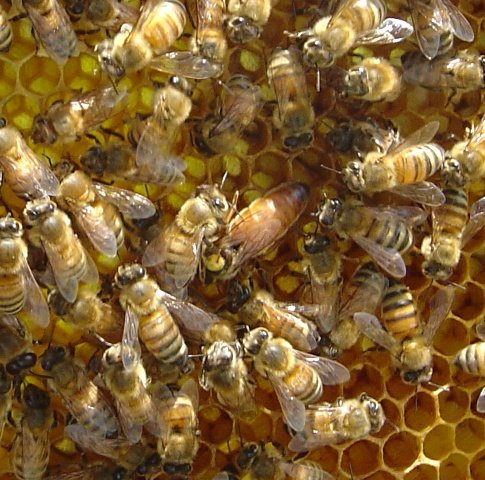As of my last post I had managed to get queen cells into cell builder colonies.
Above: 18 queen cells being removed from a queen-right cell builder colony.
Some of these cells will be placed into queen-less mating nucs
Sunday afternoon I moved the queen cells from the cell builder hives into individual queen-less mating nucs. Usually I move the queen cells on day 14 (10 days after grafting, and two days before emergence on day 16) to the individual nucs.
Above: As an experiment I kept 3 of the cells in the queen-less cell starter colony.
As you can see I ended up with larger cells.
I moved them a day early (day 13) this year, because, last year I had 16 cells destroyed when one of the cells emerged early.
Step 7 Continued:
Ok, So at this point I had 21 cells, 18 in a queen right cell builder colony, as I described last week. On the 14th day (10 days from grafting, and two days before the queens emerge) the cells should be individually placed each into its own queen-less mating nuc. Left: By adding a frame of brood to the queen-less cell starter colony, I converted it into a queen-less cell builder colony that built larger cells.
Most of my mating nucs are regular deep hive bodies that I have divided into four compartments, each with its own separate entrance. Each compartment will hold two frames. Each compartment has a cover and a sugar syrup feeder.
To make up the nucs I take frames of bees and open larva from my hives and place them into the nucs. The nurse bees will stay with the brood to take care of it.
Above Left: Cells from the queen-right cell builder. Right: Cells from the queen-less cell starter.
\I place one frame of bees and brood, and one undrawn frame into each compartment. I then introduce a queen cell (with cell protectors) into each nuc.
You can see that it takes a lot of bees to raise queens. If you have 10 queen cells you need 10 mating nucs. If you have 50 queen cells you will need 50 mating nucs.
Above: One of the cells from the queen-less cell starter, converted to a cell bulder.
You can see that there is still alot of royal jelly in the cell.
This nuc will become a little colony.
The bees will take care of the new virgin queen. In about a week she will take mating flights and mate with up to 35 drones (male bees). She will fly back to the hive, and if successful will start laying eggs in about another 7 days.
Above: Cells from the queen-right cell builder
You can see there is no royal jelly in the cell.
Did the workers rob the royal jelly to feed to worker larva in the queen-right colony?
All the cells came from the same cell starter. All the cells were over filled with royal jelly before they were placed in the cell builder colonies. There is a difference!
It is obvious that the large number of nurse bees in the queen-less cell starter colony made a big difference in the quality of the cells. I expect I will get larger queens from the larger cells. In the future I plan to abandon the use of the queen-right cell builder in favor of a queen-less cell builder assembled specifically to build cells.
Right: Red plastic cells and yellow plastic cells each contain larva grafted from different queens. The cell color tells me which queen mother the cell is from.
Additionally I took eight of the cells and arranged them so the virgin queens will emerge into queen cages. These cages have been placed into a queen-less, brood-less hive. It is my hope that the workers will care for the emerged virgin queens.
I have plans for these eight virgins I may share with you at a later date.
Tomorrow 21 queens will be emerging. This weekend I will look in on them to see how the new queens are doing.
I’ll let you know.
















